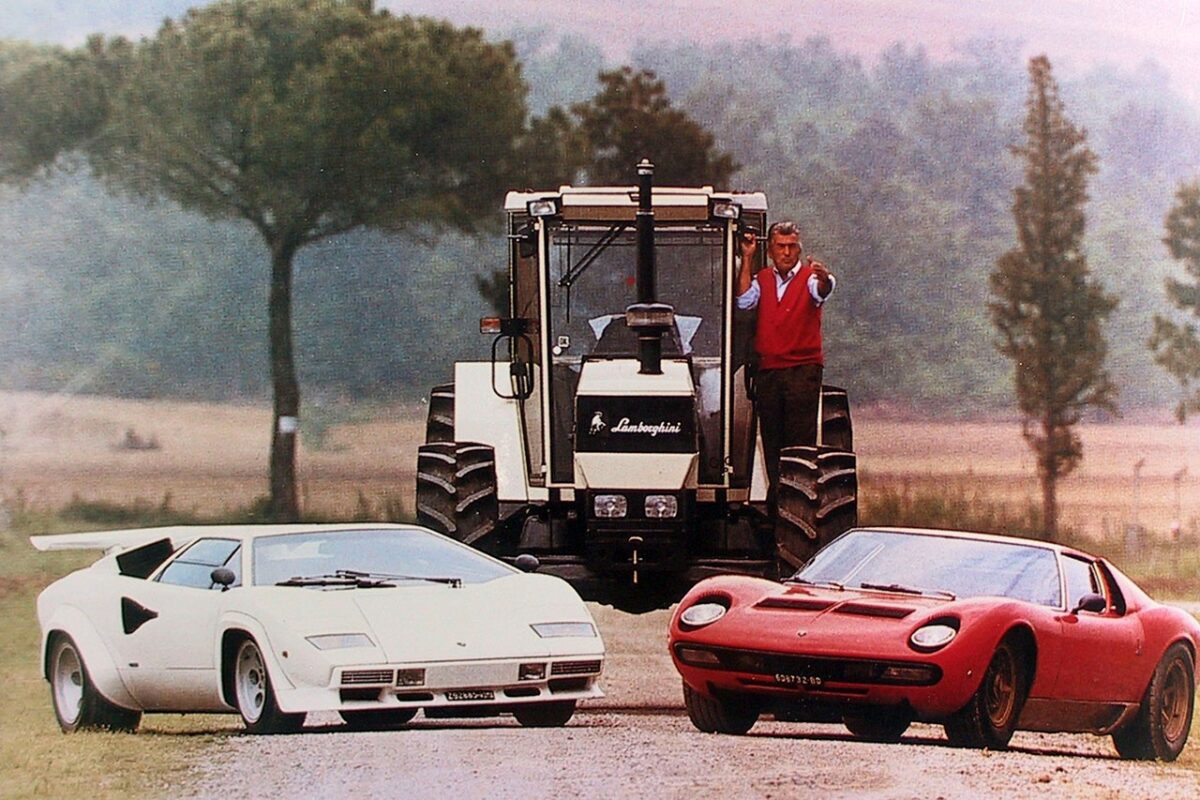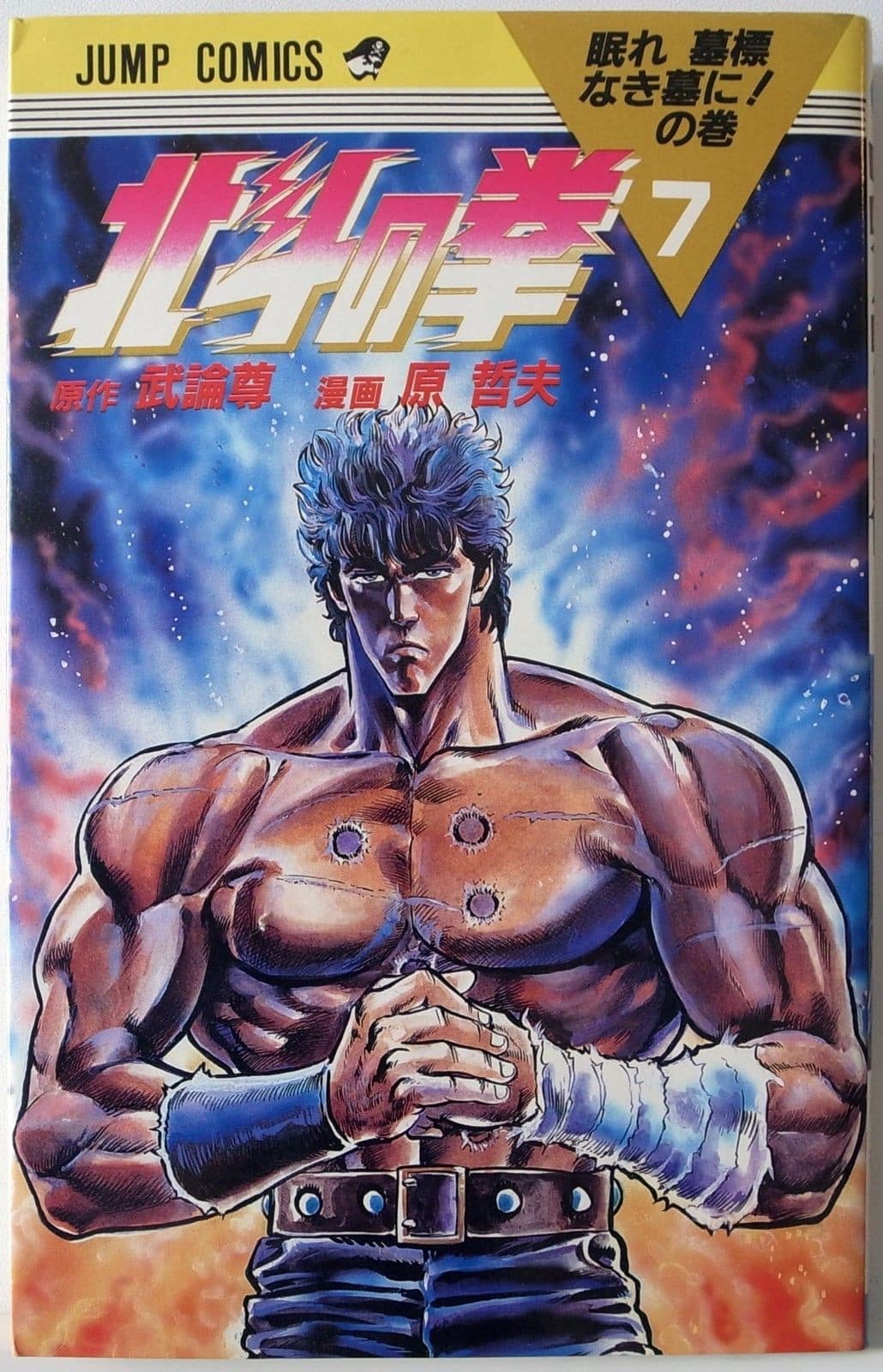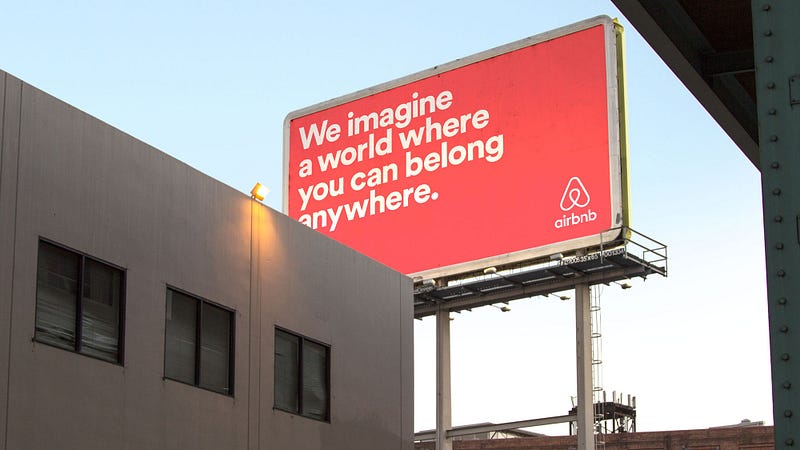How do you make a legend?
Yes, you can decode the power of a brand legend.
But first, let’s start by defining what a brand legend is not, because a lot of people tend to confuse the matter.
A brand legend is not heritage. It’s not history. It’s not fiction. It’s not a good story you tell others or yourself.
A brand legend, as I define it, is a narrative that makes people see their own lives differently.
Yes, history, heritage, a little creative license and a good story help, but they are not defining factors.
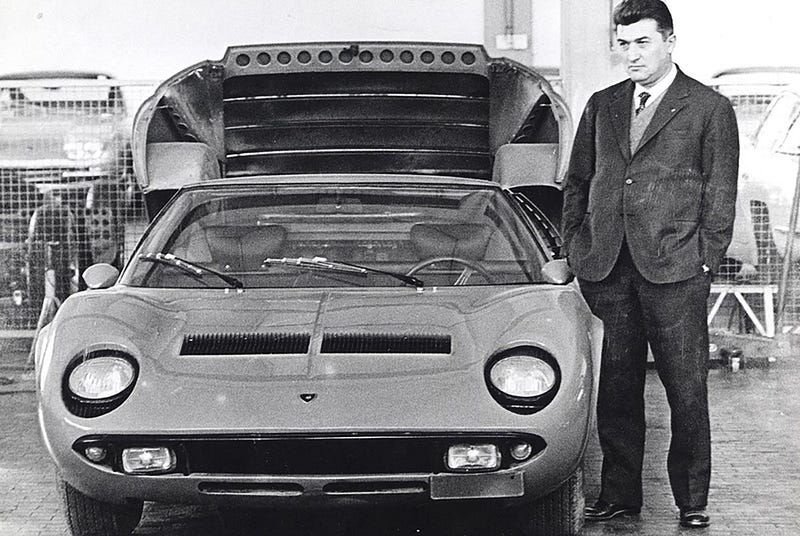
Ferruccio Lamborghini was the founder of a tractor factory that brought him huge financial success after WWII. By his 60’s, he was a rich, happy man, and like other rich and happy men of the time, he owned a Ferrari.
You’d think a luxury car would be engineered with custom parts, but Lamborghini, a mechanic himself, realized that his Ferrari 250 GT was in fact made with many of the same basic parts as his tractors — and it was part of the reason why he was often forced to take his car in for repairs.
Cheap materials in luxury vehicles confounded him, so when he met Enzo Ferrari, founder and creator of Ferrari sports cars, he naturally brought up the issue.
Two successful men talking over sports cars should have a respectable exchange, but legend has it that Enzo Ferrari, a race car driver turned manufacturer, responded with little humility, saying:
“The problem is not with the car but with driver.”
In other words, stick to your tractors, son.
It must have been a real moment, because that spectacular Italian insult changed automotive history forever.
In less than 6 months, Lamborghini bought land just outside the racing city of Bologna, built a modern manufacturing plant on it, created the first Lamborghini 350 GTV luxury sports car, and took Ferrari head on in what may have been the greatest clap back ever.
So who’s the real legend here? A race car driver whose love of fast cars pulsed through his blood?… or the self-made mechanic who showed that racer what real sports cars were about?
You can call yourself a legend, or you can make legendary moves. Lamborghini didn’t build a car. He took it upon himself to correct the course of the sports car industry.
But even more importantly, he built a brand on his belief of what it means to be an entrepreneur.
Lamborghini gives people permission to say f-you to the haters.
Lots of brands give people meaning to their purchases or a fresh lens on the world, but very few actually compel consumers to redefine their own lives by a certain standard like Lamborghini does.
Anyone can be a legend.
The very core of a legend originates from certain concepts:
- Moments of Meaning
- Bonding Memories
- Defining a Movement
We’re about to dig into all of these, but it’s important to note that legends come from action.
That means any brand, young or old, can lay the foundation for a legend that it strategically builds upon over time.
Heritage, history, content — all of those things can reinforce a legend, but they do not create one.
Like most good brand strategies, it requires a healthy dose of risk and correctly forecasting your position in a world of unknowns.
That’s not easy by any measure, but understanding how legends germinate will significantly shape your understanding of marketing forever.
Moments of Meaning
Legends have two kinds of events that thread through their brand narratives over time. The Inflection Point and Spark Moments.
— The Inflection Point is the origin story where something happened and nothing was ever the same again.
It basically says, “Something happened here, and it changed the world.”
If you look at Supreme’s legend, there is a clear inflection point where music and skate culture came together with the original mid-‘90s crew that owned the Lafayette scene in New York.
It was a critical mass of new fashion with new sport, and from that moment on, everything changed. A subculture was born, as well as a new mindset.
Today, you can see that subculture’s huge influence on modern pop culture, and it all threads back to that original inflection point in NYC.
The original crew of skaters, their love for hip hop during it’s golden era, and the immortalized stories of the Lafayette scene that played out during those years, all describe a moment where culture inflected.
— Spark Moments are definitive moments which follow the Inflection Point and cement the brand in its reputation.
These are moments where a brand overcomes challenges, pivots direction, expands to new territories (both literally and metaphorically) and so on.
Spark Moments typically pose a risk. They force your fans to either double down on their love for your brand, or dissent and walk away. They also open you up to the possibility of new audiences.
That’s exactly what happened when Supreme collaborated with Louis Vuitton. Some fans deepened their connection and shelled out more than ever to own a piece of the legend, while others declared it a sell out.
It was a clear risk, prompting Supreme to issue a statement saying, “Throughout the history of the brand, we’ve seen our customers have apprehensions whenever we do something unexpected. However, we have always stayed true to the culture from which we came.”
But for true fans, what made this Spark Moment even more meaningful was the fact that that Louis Vuitton actually sued Supreme eight years earlier back in 2000 for unlawfully using their logo on skate decks and other Supreme products.

Supreme, the irreverent, free minded brand that has always made bold moves, seemed to come full circle with a hyped Louis Vuitton collab seven years later.
(You can read more about fashion narratives like this in my article here. Paywalled, sorry.)
An ‘aha’ moment is not an Inflection Point.
The storied Silicon Valley ‘aha’ moment isn’t a true inflection point. It can be a part of a legend, but it doesn’t create a legend on its own.
The vast majority of tech founders tell their story as “I had pain point X, and that’s when I decided to fix it by inventing Y.”
While that may be true, it still falls short. Looking at the chart below, we see that ‘aha’ moments fail to capture the imagination of an audience — while these are all great brands, none of them embody a legend.
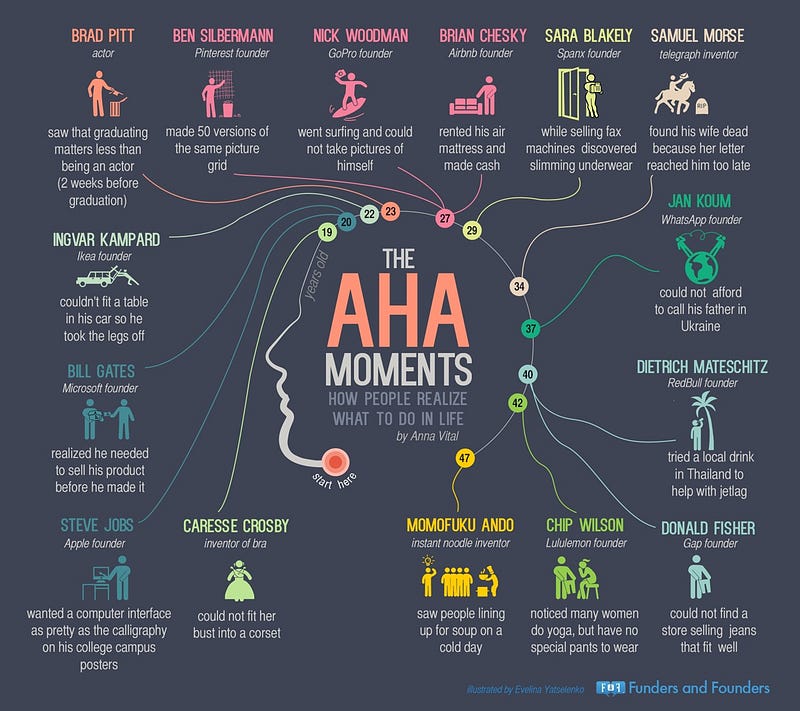
None of these stories have an inflection point. There is no exciting narrative that tells us “nothing was ever the same again.”
Except for Steve Jobs and Apple.
Jobs’ ‘aha’ moment may have been wanting a computer interface as pretty as the calligraphy on his college campus posters, as the chart above says, but what’s the one thing everyone in the world knows about the Apple legend?
That it all started in a garage.
Two oddly brilliant men, Jobs and Wozniak, not only saw the world differently, but built a new world to match that vision.
Now, the fact that the garage story is highly romanticized and amounts to little more than a myth, doesn’t deviate from it’s purpose as an Inflection Point in the legend’s narrative.
We can point to a time and a place, see it in our mind’s eye, and say “Something happened here, and it changed the world forever.”
It’s not merely about the location or the pain point. It’s the immortalization of a moment that pushed us into the future.
There is a clear before and after — one looking very different than the other.
Our perspective of the world was shifted… and keep in mind this isn’t really about the product. It’s about how the story is told.
Every major Spark Moment after that Inflection Point either forced Apple fans to double down on their love for the brand, or dissent and walk away.
Bonding Memories
Bonding memories weave a brand’s past into a consumer’s past, and Harley Davidson knows that.
From epic cross country rides to local motorcycle clubs and rallies, Harley Davidson makes sure owners not only feel a sense of tribal belonging, but also collect a series of life-defining moments for the soul.
It’s not the size and scope of these events that matters (with some rides attracting more than 10,000 bikers) so much as the commitment that‘s involved.
There’s some science to that, too. Shared experiences create a special bond among people, especially if those experiences are novel, engaging, and challenging.
Many companies try to cheat shared experiences with costly, short-lived, gimmicky experiential campaigns, but a branded experience will not create the same memories as a bonding one.
Harley Davidson knows it’s an emotional brand that supersedes the sub-par quality of the machines it makes, and that’s why they’ve chosen very unique and somewhat abstract brand pillars by which to define themselves.
https://www.youtube.com/watch?v=c5kZlrORIxU
Fire, Muscle, Bond, Icon, Rebel.
Pillars like this give a brand enough latitude in order for a consumer to find their own identity within the company.
These five words can mean so many things to different people, but are still unmistakably specific.
It’s why Harley Davidson is one of the most tattooed logos in North America.
You don’t need to host pricey events or put on big spectacles, but creating forms of initiation, belonging and life passage are all very effective markers for Bonding Memories.
How to measure the bond.
Seth Godin offers a really simple and effective way to measure how bonded people are to your brand.
Will they miss us if we’re gone?
Answering that question is easy, and a strong indicator of your brand’s bond with your audience.
If you’re a founder with an even moderate amount of success, you’ll know whether the answer is yes or no… and you’ll quickly realize that commercial success doesn’t necessarily mean people will miss if you’re gone.
You can bet Dave in Ohio with the Harley logo tattooed on his arm will miss the company if it disappeared tomorrow.
No one will miss you if you’re not willing to make some bold moves.
We miss the things that make us feel.
Define A Movement
Chanel has done a great job of managing their legend, most recently through the Gabrielle Chanel short film series.
You can watch the whole series, from beginning to end, here:
http://inside.chanel.com/en/quest-for-freedom
In these 20 frenetically breathtaking short videos, a new generation of consumers was reacquainted with Chanel’s personal inflection point as a female designer, as well as spark moments that forced the brand to further define itself after that.
The sixth film in the series, titled Mademoiselle, is especially powerful in placing Chanel in the lives and histories of all of us.
You simply cannot watch this film and not feel as though Chanel changed history, and after her, nothing was the same again.
Don’t be fooled into thinking Gabrielle Chanel was simply the embodiment of a fashion brand.
This is the story of a woman who defined a movement around femininity.
It is her hope and heartbreak, experienced against a very specific historical background that creates the initial jolt for the brand.
Something happened to Gabrielle, and to all women, in that time and place. Chanel is that moment, reforming and traveling through the here-and-now.
Legends aren’t just subjects of good stories, they are the story themselves. When a new brand defines a movement, concept or category, they make a move toward permanence.
You can create something new, or recreate something already done, but every brand from Apple to Nike has created their space and/ or recreated a space ready for change.
Chanel’s story is quickly revealed as a feminist movement.
Marriage, class, equality, gender roles and sexuality are top line issues punctuated throughout the brand’s legend.
That applies just as much today as it did decades ago.
That’s the beauty of a legend that defines a movement. It can be reinvented and couched in an updated context from generation to generation.
Borrow the things you cannot own.
Shinola is no Chanel, but they’ve found a way to borrow the history of a town in order to ‘cheat’ a certain kind of heritage.
In the article The Real History of America’s Most Authentic Fake Brand, journalist Stacy Perman describes a brand that has borrowed American history to create a bond.
With Shinola, Kartsotis has performed a near magical marketing act — creating an artificial heritage brand by co-opting others’ rich American histories…
If the Shinola name feels vintage, that’s because it is. In 2010, his outfit reportedly spent some $1 million to buy the name of the long-defunct American shoe polish remembered today for being part of a World War II-era insult — “You don’t know shit from Shinola” — and reanimated it with a new narrative…
Most important, by hatching the brand in Detroit — a city emblematic of American hardship, resilience, and craftsmanship — the brand is selling more than watches; it’s selling a comeback.
For those in the know, the brand can feel contrived, but for many others it’s the real deal worth buying.
You don’t need to co-op heritage to the degree that Shinola has, but if you’re a new brand, you can find ways to tap into a story bigger than yourself.
Shinola found a hidden story (Detroit’s resilience), dusted it off, and told it properly.
You can claim your part of a larger story as well.
Brand legends come from action.
It’s your choices that will make you legendary.
It’s the big moves that people remember.
It’s just that simple.
Any brand in any category can be a legend, so long as you build the right story from the ground up and nurture that story with constant reinforcement.
Yes, it does take a good deal of luck and an even greater deal of restraint to stay the course, especially if you’re a marketer tasked with short-term growth… but brand strategy is often a longer-term game.
Take deliberate action and build a brand that makes people see their lives differently.

